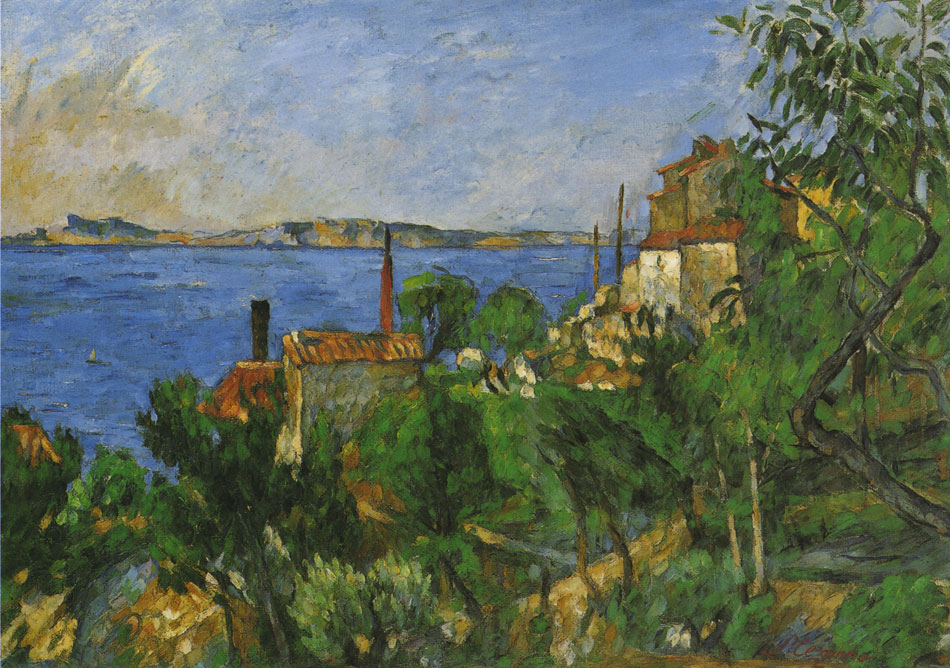| |
| BACK TO THE ARTIST |
| |
The Seat at L'Estaque, 1876 |
| |
| |
 |
| |
| |
| |
| Details |
|
|
Description |
| |
|
| Artist |
Cézanne, Paul |
In June and July of 1876 ,Cezannereturned to L’Estaque. A famous letter to Pissarro, dated July 2, informs us about his sojourn and the poor weather – “It rains her every week two days out of seven. This is flabbergasting in the Midi.It’s never been seen before.” – and above all about the many projects inspired by places he seems to be discovering for the first time, despite his having studied them a few years earlier.
“I have begun,” he wrote Pissarro, “two small motifs with the sea, for Monsieur Chocquet, who had spoken to me about it. – It’s like a playing card. Red roofs against the blue sea. If the weather turns favourable I might be able to finish them off. Given the circumstances , I haven’t done anything yet – But motifs are to be found that would require three or four months of work, for the vegetation doesn’t change here. It’s olive trees and pines, which always keep their leaves. The sun here is so frightful that it seems to me the objects are silhouetted not only in white or black, but in blue, red, brown, violet. I could be wrong, but it seems to me that this is the opposite of modelling.” And by way of conclusion, after suggesting that the “gentle landscape painters from Auvers” join him, he announce that, on a future sojourn to be arranges as soon as possible, he would undertake “canvases of two meters at least.”
The few lines – comparable to Degas’s 1873 letters detailing his discovery of Louisiana – are quite remarkable:Cezannehad experienced the revelation of the Midi, of everything that this region, which he thought he knew so intimately, had to offer his painting if only he could manage to transcribe its violent light, its brutal contrasts , its exacerbated colours. The appeal he addressed to his colleagues in Auvers, to Pissarro and Guillemet above all, amounts to an implicit condemnation of an impressionism devoted to coloristic subtlety, to handling that was splintered and vibratory. The landscape of L’Estaque prompted him to summarise what was before his eyes, reclaiming the simplicity and the absence of modelling found on playing card images, and the resulting paintings paved the way for the “synthetic”Cezanneof the 1880s.
When shown in 1877 at the third Impressionist exhibition, along with the portrait of Victor Chocquet, who had commissioned it, this Landscape, Study after Nature – a titleCezannegave to four of the exhibited works – was scarcely noticed, perhaps because it was poorly hung, “above a door , in the second room.” But this neglect was more likely due to its relative awkwardness in comparison with the surrounding Impressionist landscapes. It was described as “strange” by the reviewer for L’Evenement, who took delight in ridiculing it : “M.Cezanneexhibits a strange land cape which demonstrates that he had been violently impressed by two things: spinach and cobbling. Its green makes one shudder, and a clump of trees in the foreground seems exactly like a row of boots cringing in horrible pain.” |
| |
| Date |
1876 |
| |
| Institution |
Fondation Rau pour le Tiers Monde, ZZrich |
| |
|
| Medium |
Oil on canvas |
| |
| Dimensions |
42 * 59 cm |
| |
| |
| |
| |
| |
| |
| |
| |
| |
| |
| |
| |
| |
| |
| |
| |
| |
| |
| |
| |
| |
| |
|